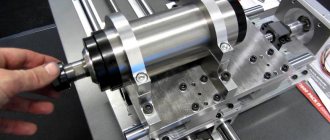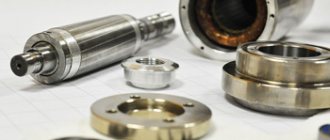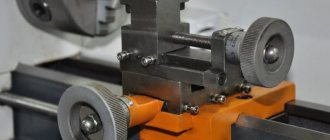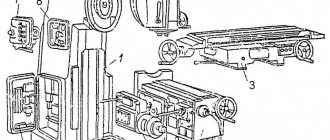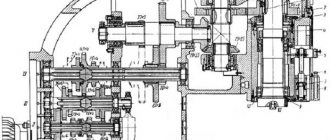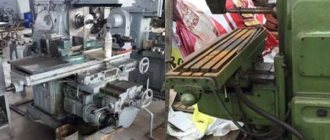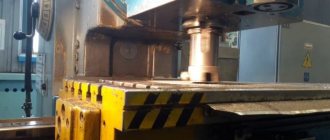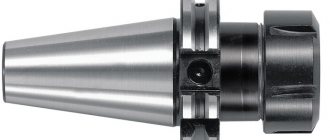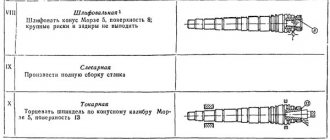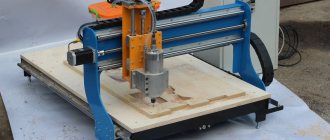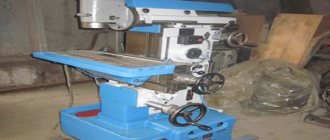The phrase “spindle for a CNC milling machine” usually means a motor with a self-clamping collet chuck installed on it (like on a manual milling machine), which serves to fix a cutting tool, such as a milling cutter, whetstone, drill, etc. and transmitting rotational motion to it at high speed.
Classification
They can be divided into 2 small groups - domestic and industrial:
- Household ones include various drills, small household milling cutters or drills.
- Industrial engines include engines designed to withstand high loads during operation, having ceramic bearings and often equipped with a complex liquid or air cooling system and a lubricant supply system directly to areas with high levels of friction and heating.
When using a drill as a spindle in a home CNC machine, you need to understand that its bearings are not designed for high lateral loads and will very quickly begin to “howl”, which can lead to high heating of the windings, a decrease in power on the shaft, and subsequently such a spindle will simply will burn.
In this case, cooling will not help, and it is necessary to modify the drill itself, namely: replace the ball bearing of the shaft with a roller bearing (preferably with ceramic rollers), firmly fix it in the body and take care of the constant presence of lubricant in it.
3kW - with collet ER-20
Main spindle for 3D work with hardwood, acrylics, metals and shallow cutting depths up to 4mm for stone. The spindle has a nut with a diameter of 34mm. The shaft diameter is 24mm - a normal shaft that is already difficult to bend. It is permissible to work with a figured cutter at full depth with small feeds. The range of clamped drills and cutters up to 13mm in diameter. Technical requirements for cutting/cutting solid wood: use cutters up to 12.7mm in diameter to a cutting depth of 50mm. When working on steel, use cutters with a diameter of no more than 5 mm to a cutting depth of maximum 15 mm. Consumption from the network at the right loads is no more than 600 W/hour. 2 types of spindles with this power are produced: up to 18 thousand revolutions and up to 24 thousand revolutions. If you plan mainly to do small engraving and milling, as well as work with metals, then you should choose a spindle with 24 thousand rpm, because a spindle with a lower number of revolutions has the worst efficiency in terms of profitability for small-scale work, especially with metals when processing hard cutters; in addition, the horizontal speed of wood processing will have to be reduced by 1.3 times to prevent cutter breakage. Example: if a spindle with 18 thousand revolutions processes wood at a horizontal speed of 4.5 m/min, then with a spindle with 24 thousand revolutions wood is processed at a horizontal speed of 5.85 meters per minute. Supply voltage 220v. Often there are such spindles with 380v 3 phases, which will not allow you to power the machine from an inexpensive uninterruptible power supply. It is prohibited to install cutters with a total length exceeding 100 mm in spindles of this type. Longer cutters will break up the spindle bearings.
Features of the spindle depending on the type
Basically, during the operation of milling machines, all loads are perpendicular to the spindle axis, and parallel loads appear only at the moment of cutting into the body of the workpiece. That is why it is necessary to choose an engine that can withstand such loads over a long period of time, since the operation of milling machines can be continuous for a day or even more.
Spindles intended for industrial purposes do not require constant cleaning and lubrication of bearings throughout their entire service life, but if you begin to notice extraneous sounds in its operation at idle, it is still better to disassemble the motor housing and blow out all contaminants from the inside with compressed air (if such are present) and lubricate the bearing well with a special lubricant that does not lose its properties at high temperatures.
In addition, the industrial spindle is equipped with a high-quality collet chuck that has minimal runout during operation, ensuring the necessary processing accuracy, a minimum difference between the actual and actual size of the cutter, and allowing the clamping of cutters with a conventional cylindrical shank.
Collet clamps
Basically, the most common are collets of the ER11 and ER16 types, into which a drill or cutter with a shank diameter of 2.5 to 3.2 mm is inserted, even if it is made with a cone. There are also chucks designed for a larger tool diameter, but they are used for rough metal processing or steel milling and have a hole for tool clamping of 6 millimeters or more.
Why can't I install it on my home CNC machine, you ask?
If you clamp a cutter with a diameter of 2 mm with a shank diameter of 3.2 mm into a collet chuck, then during processing you will hardly notice the difference, but if you install a cutter with a diameter of 10 mm and a shank of 3.2 mm on an amateur machine, then you can easily deform the guides, since the load on in this case increases significantly. In a machine, all parts must fit perfectly together, otherwise there will be more problems with it than quality work. Therefore, we recommend that you opt for the EP-13 collet; it is quite sufficient for small volumes of work and is suitable for almost any working tool used in processing various materials.
Spindle 500W for CNC milling - review + spindle operation
Hello, in this review we will look at a budget spindle with a power of 500w 11000rpm. The spindle is equipped with a dimer for adjusting the speed + the package includes a clamp for mounting the motor on the “Z” axis. Characteristics:
— Dimer power supply: AC110-220V ± 10% 50/60 Hz — Spindle power 500w — Spindle rotation speed 3000-12000 rpm — Spindle diameter 52mm — Spindle length 208mm — Spindle operating voltage 100V DC — Torque 5000G/CM — Chuck on spindle: ER11
Contents:
1 x 500W spindle motor 1 x power supply 1 x 52mm mounting bracket 1 x ER11 (chuck mounted on motor) 4 x mounting bolts
The total length of the spindle is 208 mm.
The diameter of the motor housing is 52 mm.
A plastic impeller is installed on top of the shaft, which gently blows air over the motor during operation.
At the bottom end of the motor there are mounting holes for M4 bolts.
Chuck measurements
When purchasing a set of collets, pay attention to their size; in this case, the required collets are ER11 - ER11 is the outer diameter of the collet that will fit the chuck mounted on the motor.
The cartridge is mounted on a shaft with a diameter of 8 mm.
To fasten the spindle to the “Z” axis plate, the package includes an aluminum clamp and four M4 bolts
The inner diameter of the clamp when not tightened is 52 mm.
Plus, the aluminum clamp removes heat from the motor well.
To control the motor speed, a simple dimer is used, assembled on a PWM controller. The dimer operates from an alternating voltage of 110V - 220V (on the side of the case there is an input voltage switch, in our case it is set to 220V).
The maximum output voltage to the motor is DC 100V.
Metal case dimensions:
A variable resistor is used to regulate motor speed.
resistor
Let's look at what's hidden in the metal case. By the way, one of the aluminum sides of the case serves to remove heat from the transistor and diode screwed to it.
Let's take a look at the motor:
I put everything back together and connected the wires to check the motor. It's time to install the spindle on the machine and see it in operation.
To fasten the clamp, the kit includes four bolts, but alas, for my needs the bolts are short, it seems that the manufacturer intended that the bolts be screwed directly into the threaded plate.
The spindle is secured and ready for work, I installed the spindle control unit in the main body where all the machine electronics are assembled. By the way, the control unit is barely warm when the engine is loaded for several hours.
Bottom line, a budget spindle for a small machine; 500W is enough for my tasks, but I would like more revolutions. This spindle worked for me and does not work for very long, but I cut several wood models and there is no play observed. This spindle can easily cope with wood, plastic, plexiglass; aluminum can be engraved or cut in several passes at minimum speed. The operating temperature during long-term operation of the spindle reached 40 degrees. Video review + operation of a spindle with a wood cutter installed: Wood processing begins at 5:20 along the time track of the video. Links to the cutters that I used to process the model are in the video description.
The product was provided for writing a review by the store. The review was published in accordance with clause 18 of the Site Rules.
Spindle power
When choosing spindle power, you must be guided by the golden rule - the more, the better. Basic rules when choosing power:
- If you plan to use milling machines only for drilling or engraving small parts, then a spindle with a power of up to 600 watts will be quite sufficient.
- For milling hardwood and metal, you need to consider a motor with a power of 600 to 1400 watts.
- If you plan to further modernize the machine (there are machines with two spindles or more) or you need a large power reserve, you need to look towards spindles with a power of over 1.6 kW, they will allow you to process almost any materials, and the quality of work will depend only on the reliability of the mechanical part of CNC machines.
Spindles for benchtop milling machines
The milling spindle is the main structural unit of a CNC machine, which allows you to secure the cutting tool and transmit rotational motion to it.
- When equipping a household CNC machine, a regular engraver is often used as a spindle. The power of a typical product is 125 W. The disadvantages of the engraver are its weak rotational movement, which does not allow it to process hard materials.
- An alternative option is a drill. Unlike an engraver, a drill is quieter, and in terms of power and rotational movement it is not inferior to an engraver in strength and speed. In addition, the drill is equipped with a strong clamp.
- To install a spindle on a household CNC machine, grinders and milling machines are used. The operation of such a design will allow you to process products made of wood, plywood, and soft metals. Typically, a collet clamp (6 mm) is included with the product, for which standard 6 mm are produced. adapters that allow you to fix cutters with a diameter of 0.1–6 mm. The disadvantages of the mechanism are loud noise during operation and the absence of a speed controller, which creates problems when processing polymers, where lower speeds are required.
- The spindle from the Sparky router is suitable for working with plastics. The power of the milling machine ranges from 500–1050 W. Some models of the brand are equipped with a speed controller and are suitable for processing plastics. Working with plastic requires low speeds, with sufficient power, which avoids heating and melting of the material, without loss of performance.
When choosing a device according to the price-quality scheme, an acceptable solution to the issue is a Kress milling cutter, the spindle of which is successfully used for household CNC milling machines. Products of this brand are equipped with a system that minimizes runout and are designed for long-term use.
By carefully approaching the equipment of a milling machine, you can equip the unit with a professional spindle with a lubricant-emulsion cooling system. In addition, the design is equipped with: four bearings, which improve the accuracy of processing parts, and durable brushes designed for long-term operation. The disadvantage of professional spindles is the high price, which is offset by the reliability and performance of the products.
Cooling
As mentioned above, spindles can be equipped with either air or liquid cooling. The air blower is a conventional impeller mounted on the motor shaft and blowing air over its windings.
The big disadvantage of this type of cooling is the fact that the impeller not only forces air onto the hot motor, but also sucks chips, dust and everything that the cutter cuts out of the workpiece into its housing. Also, when processing at low speeds, air cooling is ineffective, since it directly depends on the rotation speed of the spindle shaft.
The water cooling system does not have such a disadvantage, but when using it, a separate place is required for the reservoir with coolant and proper fixation of the tubes with it on the body of the milling machine, which greatly complicates the design if it is a two-spindle milling machine.
It is much more efficient than an air cooling system, since the speed of fluid flow through the spindle is the same all the time thanks to the use of a special pump. The main condition that must be observed when having a water-cooled spindle is that you cannot turn on the engine without turning on the pump, since in this case it will not cool at all, will overheat very quickly and, as a result, will burn out.
Cooling methods
When working on a milling machine, the fixed part overheats and may collapse. To reduce the temperature that occurs when processing a product with a milling cutter, the following cooling methods are used:
- air;
- lubricant-emulsion.
Air cooling
The air cooling method is often used on modern CNC machines. The essence of the method is to direct air through nozzles onto the surface of the part equipped with air intakes. The disadvantage is that filters become clogged when processing materials that produce a lot of dust.
It is also widespread to cool parts using lubricating-emulsion liquids, which have a positive effect on the metal cutting process:
- At the point of contact between the cutter and the part, a protective, lubricating film is formed, which reduces friction and heat generation.
- Excess heat is removed from the workpiece being processed.
- The formation of built-up edge on the cutting edge of the cutter is stopped, which improves chip removal.
In addition, emulsion lubricants protect finished products from corrosion.
Air cooled spindle
